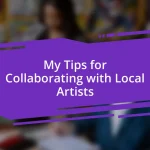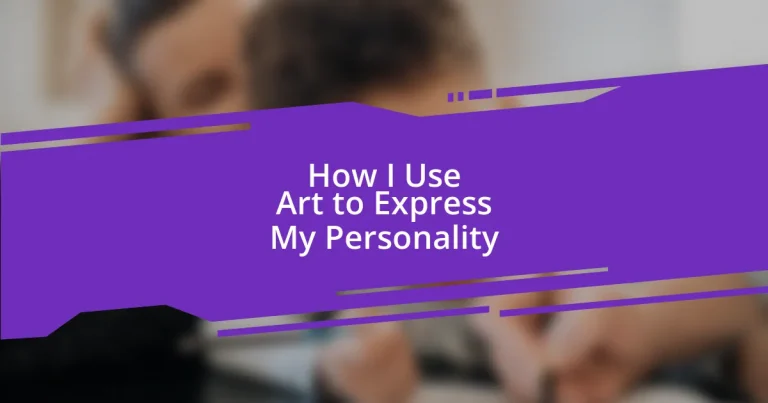Key takeaways:
- Art serves as a profound means of self-expression and emotional exploration, reflecting personal identity and experiences.
- Shifts in artistic style and medium correlate with different life phases, revealing aspects of personality and introspection.
- Sharing art fosters community and connection, transforming personal narratives into collective experiences that promote growth.
- Creating a supportive creative community enhances artistic development and helps individuals navigate challenges like art block.

Understanding the role of art
Art often serves as a mirror reflecting our inner selves. I remember a time when I created a piece inspired by a difficult period in my life. Every brushstroke conveyed my emotions—fear, hope, and resilience—but it also opened a dialogue with those around me. Hasn’t everyone felt that urge to share a part of themselves through creative expression?
For me, art transcends mere aesthetics; it acts as a vital means of connection. I’ve found that sharing my work can bridge gaps between people, sparking conversations that might not have happened otherwise. Isn’t it fascinating how a simple painting can ignite discussions about our shared experiences?
Moreover, the process of creating art allows me to explore my identity in profound ways. When I sketch or paint, I feel as though I’m unraveling layers of who I am, one stroke at a time. It raises the question: What do we discover about ourselves when we allow creativity to flow freely into the world? Each piece becomes not just a product but a journey of self-exploration.

Exploring personal artistic styles
When diving into personal artistic styles, I’ve realized that our choices reflect distinctive aspects of our personalities. For instance, I used to favor bright, bold colors in my pieces, an outward expression of my lively, extroverted side. But as I evolved, I found myself gravitating towards more muted tones, which I believe echoed a deeper sense of introspection. This shift revealed how my artistic voice adapts as I navigate different phases of my life.
- Bright colors and bold strokes: Expressing my youthful exuberance.
- Muted tones and softer lines: Reflecting times of contemplation.
- Mixed media: Blending various influences and experiences to tell a more layered story.
- Abstract styles: Allowing freedom from realism, tapping into emotions that words can’t articulate.
Every choice I make in my art resonates with my journey, each piece fostering deeper connections to my identity. It’s a constant dialogue between who I was, who I am, and who I strive to become.

Choosing the right medium
Choosing the right medium feels like selecting a voice for my thoughts. Each form of art, whether it’s painting, drawing, or digital design, provides a unique lens through which I express my personality. I remember when I started experimenting with watercolor; the transparency of the medium allowed me to convey fragility and elegance, resonating with my softer side. Isn’t it incredible how the right medium can encapsulate emotions so effectively?
I’ve noticed that my choice of materials often corresponds to my mood. For example, when I reach for charcoal, it’s a sign I need to depict raw emotions—sharp, bold strokes that convey intensity. I can almost hear the scratching sound as I pour my feelings onto the paper. The contrast with smoother mediums like oil paint allows for a more subtle, layered expression—perfect for times when I’m navigating complex feelings. Isn’t it interesting how different tools can unlock various facets of our emotional landscapes?
It’s also about the spontaneity the medium allows. With collage, I can juxtapose images that seem unrelated, creating stories that reflect my chaotic yet vibrant inner world. This fluidity complements my evolving sense of self. Choosing the right medium isn’t just about technique; it involves understanding which tools resonate with the current chapter of my life. Exploring these choices has been a fascinating journey of self-discovery.
| Medium | Emotional Insight |
|---|---|
| Watercolor | Captures fragility and elegance in my softer moments. |
| Charcoal | Depicts raw intensity; perfect for expressing strong emotions. |
| Oil Paint | Allows for subtle, layered expressions during complex feelings. |
| Collage | Creates narratives from chaos; reflects my vibrant, multifaceted identity. |

Techniques for self-expression
When it comes to expressing myself, I often turn to various techniques that resonate with my emotions. One of my favorites is abstract art, which gives me the freedom to let my feelings flow without the constraints of realism. I vividly remember creating a piece where I splashed vibrant hues across the canvas; it felt liberating. I like to think of it as a dance of colors, a dynamic reflection of my inner joys and struggles. Have you ever tapped into that freedom through art?
I’ve also found that combining different media, like photography with traditional painting, enhances the depth of my expression. One time, I superimposed my photographs onto painted backgrounds to portray contrasting layers of my identity. The result was striking—a visual representation of how my experiences are interwoven. That exploration made me ponder: how do our diverse experiences shape the art we create? For me, blending techniques allows each piece to tell a multi-faceted story representative of my life.
Movement in my art is another technique I cherish. I often incorporate gestures and rhythm into my work, almost like a visual heartbeat. When I let my body move with the brush, it feels as if I’m transferring my energy directly onto the canvas. It’s exhilarating! This dynamic approach adds a sense of vitality to my creations, making me wonder whether physicality in art can ignite emotional connections. What do you think? Does movement enhance your creative expression too?

Sharing art with others
Art is something I love to share, and that process invigorates me in unexpected ways. Recently, I hosted a small gathering where friends brought their own art pieces. It was such a joy to see their individual expressions come to life. We spent hours discussing the inspirations behind each piece, and it felt like uncovering different layers of our personalities. Have you ever felt that sense of connection when sharing art? It’s like opening a window into each other’s souls.
When I share my work online, there’s a mix of excitement and vulnerability. I remember posting a painting that captured a particularly challenging moment for me. The comments I received were heartfelt and made me feel seen. Many people shared their own stories and struggles, creating a sense of community that I hadn’t anticipated. Isn’t it fascinating how art can transcend our personal experiences and create a shared narrative?
I also enjoy organizing art swaps with fellow artists. Each time, I get to explore how someone else interprets themes I hold dear. One memorable swap yielded a piece that reflected my journey with self-acceptance, created by a friend who had her own struggles. That exchange added depth to my understanding of both my art and hers. Isn’t it wonderful how sharing art can turn into an enriching dialogue that fosters growth?

Reflecting on personal growth
Reflecting on my personal growth through art often leads me to a deep introspection. I remember a time when I created a self-portrait that didn’t quite look like me—it’s like I captured not just my external features but my inner turmoil. That experience taught me that sometimes what we express on the canvas reveals more about our emotions than we realize. Isn’t it intriguing how art can unfold layers of ourselves that we might still be discovering?
As I delve into my artistic journey, I recognize that each piece I create serves as a timestamp of my development. For instance, there was a phase when I focused solely on dark colors, mirroring my mood at the time. Looking back, I see how that period of my life was pivotal—it forced me to confront my feelings rather than hide from them. Have you ever noticed how certain artworks can signal the moments of change in your own life?
With every brushstroke or layer added, I find myself evolving. I recall a time when I faced self-doubt about my artistic abilities. After joining a group where we critiqued each other’s work openly, I began to view feedback not as criticism but as an opportunity for growth. This shift in perspective has made my art more vibrant and layered, echoing the journey of learning and resilience. Don’t you think that sharing our struggles can empower us as creative individuals?

Building a creative community
Building a creative community is something I find profoundly enriching. I started a group on social media specifically for artists, and I was overwhelmed by how quickly it grew. Every week, members share not only their art but also their creative processes and challenges. It’s incredible to witness how our exchanges cultivate a supportive environment where everyone feels encouraged to push their boundaries. Have you ever felt like you belonged to a community that truly understands you?
Once, during a live virtual art session, I was amazed at how we bonded over technical mishaps—people embracing their so-called “mistakes” and turning them into unexpected masterpieces. It reminded me that creativity isn’t about perfection; it’s about exploration and fun. This atmosphere of openness helped foster not just artistic growth but deep friendships that extend beyond the canvas. Don’t you think it’s powerful when art can bring us together in such a meaningful way?
Creating a sense of community can also be about finding common ground in our challenges. I remember discussing art block with fellow artists, revealing how it often feels isolating. But by sharing stories of struggle and triumph, we uplift each other and find new sources of inspiration. Isn’t it fascinating how opening up about our difficulties can strengthen the bonds between us? In this way, art becomes more than a personal expression; it becomes a collective journey of growth and understanding.














